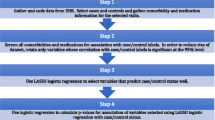Abstract
Compliance to evidenced-base practices, individually and in ‘bundles’, remains an important focus of healthcare quality improvement for many clinical conditions. The exact probability distribution of composite bundle compliance measures used to develop corresponding control charts and other statistical tests is based on a fairly large convolution whose direct calculation can be computationally prohibitive. Various series expansions and other approximation approaches have been proposed, each with computational and accuracy tradeoffs, especially in the tails. This same probability distribution also arises in other important healthcare applications, such as for risk-adjusted outcomes and bed demand prediction, with the same computational difficulties. As an alternative, we use probability generating functions to rapidly obtain exact results and illustrate the improved accuracy and detection over other methods. Numerical testing across a wide range of applications demonstrates the computational efficiency and accuracy of this approach.





Similar content being viewed by others
References
Institute for Healthcare Improvement, Bundle up for safety. Available at http://www.ihi.org/resources/Pages/ImprovementStories/BundleUpforSafety.aspx
Center for Medicare & Medicaid Services. 2003. Clinical conditions and measures for reporting and incentives. Available at http://www.cms.hhs.gov/HospitalQualityInits/35_HospitalPremier.asp
JCAHO (2006) Raising the bar with bundles: treating patients with an all-or-nothing standard. Joint Commission Perspectives on Patient Safety 6:5–6
McGClarkson D (2013) The role of ‘care bundles’ in healthcare. Br J Healthc Manag 19(2):63–68
Berwick D, Calkins D, McCannon J, Hackbarth A (2006) The 100,000 lives campaign: setting a goal and a deadline for improving health care quality. J Am Med Assoc 295:324–327
Resar R, Pronovost P, Haraden C, Simmonds T (2005) Using a bundle approach to improve ventilator care processes and reduce ventilator-associated pneumonia. Joint Commission Journal of Quality and Patient Safety 31(5):243–248
Fulbrook P, Mooney S (2003) Care bundles in critical care: a practical approach to evidence-based practice. Nursing in Critical Care 8:249–255
Rello J, Lode H, Cornaglia G, Masterson R (2010) A European care bundle for prevention of ventilator-associated pneumonia. Intensive Care Med 36:773–780
Marwick C, Davey P (2009) Care bundle: the holy grail of infectious risk management in hospital? Curr Opin Infect Dis 22:364–369
Benneyan J, Taseli A (2010) Exact and approximate probability distributions of evidence-based bundle composite compliance measures. Health Care Management Science 13(3):193–209
Benneyan J, Borgman D, 2004. A useful J-binomial type distribution for non-homogeneous dichotomous events. Industrial Engineering Research Conference Proceedings, 1–6.
Benneyan J, Harris B, Taseli A, 2007. Applications and approximations of heterogeneous weighted and unweighted j-binomial probability distributions. Proceedings of the 37th International Conference on Computers and Industrial Engineering, 1910–1921.
Wang Y (1993) On the number of success in independent trial. Stat Sin 3(2):295–312
Benneyan J, Borgman A (2003) Risk adjusted sequential probability ratio tests and longitudinal surveillance methods. Int J Qual Health Care 15(1):5–6
Taseli A, Benneyan J, 2009. Risk adjusted spatial scan statistics, IIE Industrial Engineering Research Conference, 2289–2294.
Chen B, Matis T, Benneyan J (2011) Improved one-sided control charts for the mean of a positively-skewed population using truncated saddlepoint approximations. Qual Reliab Eng Int 27(8):1043–1058
Hong Y (2013) On computing the distribution function for the Poisson binomial distribution. Computational Statistics and Data Analysis 59:41–51
Wolfram Research Inc. Mathematica 7.0, 2008. http://reference.wolfram.com/mathematica/ref/CoefficientList.html
Nolan T, Berwick D (2006) All-or-none measurement raises the bar on performance. Journal of American Medical Association 295:1168–1170
Benneyan J (2008) Statistical performance of composite versus all-or-nothing measures of core measure bundle compliance: which is better? Quality and Safety in Health Care 17(3):227
Author information
Authors and Affiliations
Corresponding author
Rights and permissions
About this article
Cite this article
Chen, B., Matis, T. & Benneyan, J. Computing exact bundle compliance control charts via probability generating functions. Health Care Manag Sci 19, 103–110 (2016). https://doi.org/10.1007/s10729-014-9290-2
Received:
Accepted:
Published:
Issue Date:
DOI: https://doi.org/10.1007/s10729-014-9290-2




